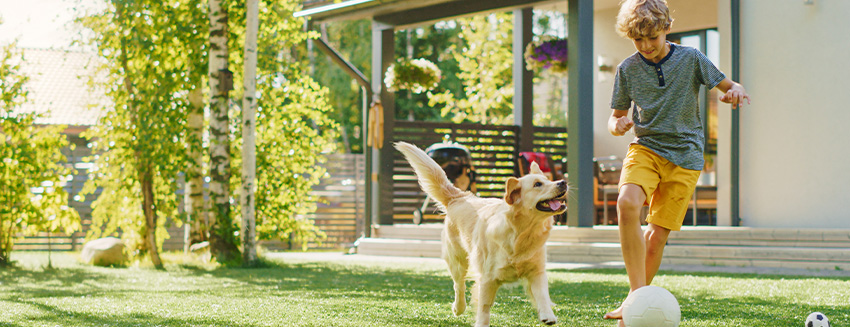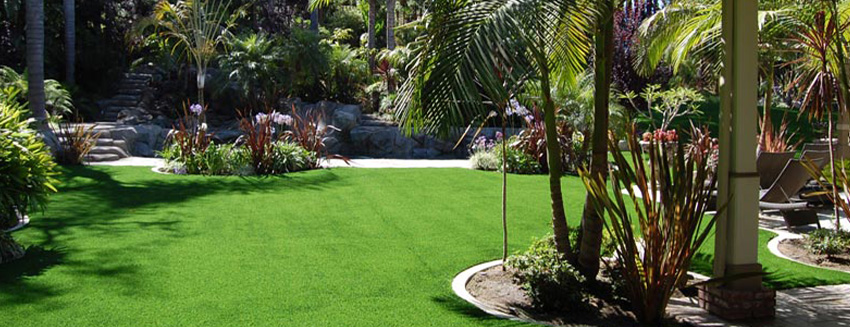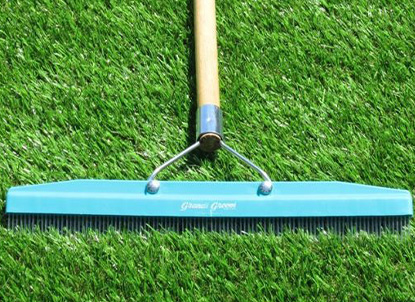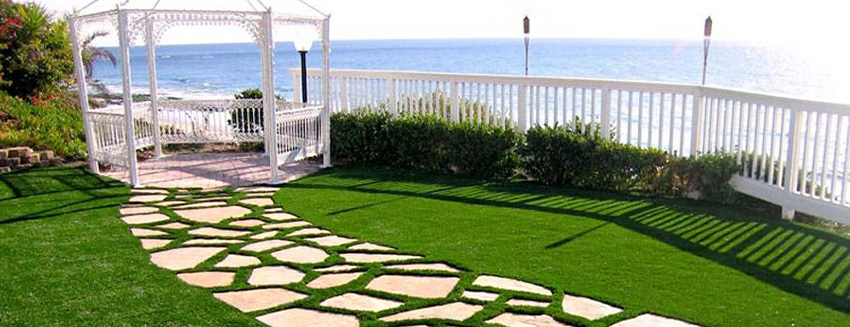How to Maintain and Clean Artificial Grass:
Keep Your Grass Beautiful All Year-Round
Artificial grass makes having a lawn so much easier. However, even though you no longer have to mow, there are still some maintenance practices to consider for your artificial grass.
By learning how to clean artificial grass, you can prolong its livelihood and maximize your investment. To ensure you know how to clean artificial grass, let’s go over weekly cleaning routines, monthly maintenance, pet grass care, and what cleaning methods to avoid.
By learning how to clean artificial grass, you can prolong its livelihood and maximize your investment. To ensure you know how to clean artificial grass, let’s go over weekly cleaning routines, monthly maintenance, pet grass care, and what cleaning methods to avoid.
9-Step Guide to Cleaning Artificial Grass

Step 1: Clear Debris Begin by removing easily clearable debris like leaves and twigs. Use a leaf blower for quick clearance or a soft-bristled broom for a gentler approach. This primes your turf for a deep cleaning.
Step 2: Spot Cleaning for Stains Treat any spills or stains. For liquid spills, blot the area with a cloth to absorb as much as possible before rinsing with water. For more stubborn stains, apply a mixture of mild detergent and water, gently scrubbing with a soft brush before rinsing.
Step 3: Apply an Appropriate Turf Cleaner Choose a cleaner suitable for synthetic grass, focusing on non-toxic options to protect your turf’s integrity. Spray the cleaner over the turf and use a brush to gently work it into the fibers, particularly in areas with heavy soiling.
Step 4: Deep Cleaning with a Hose After applying the cleaner, thoroughly rinse the turf using a garden hose. Ensure that all cleaner residue and loosened dirt are washed away, as these can attract more dirt and degrade the turf material.
Step 5: Brush the Turf Once the turf is clean and dry, use a synthetic turf brush to gently comb the fibers. This helps to keep them upright and restore the natural look of the grass. Brushing also helps to evenly distribute infill material, maintaining the turf’s cushioning effect.
Step 6: Check and Replenish Infill Inspect the level of infill material, which helps support the grass blades and keeps them standing upright. If the infill has compacted or diminished, add more to maintain the turf’s resilience and drainage capabilities.
Step 7: Sanitize the Area For areas that receive high traffic or have had significant pet activity, consider using a turf sanitizer to eliminate bacteria and ensure a hygienic surface. Follow the manufacturer's instructions for application to avoid damaging the turf.
Step 8: Address Weeds and Moss Inspect the edges and seams of your turf for weeds or moss. Pull any weeds by hand or use a mild herbicide if necessary. For moss, a diluted vinegar solution can be effective. Be cautious with any chemicals to prevent damage to the synthetic materials.
Step 9: Final Inspection and Grooming Do a final inspection of the turf to ensure all areas are clean, free of debris, and the blades are uniformly upright. Address any irregularities or compacted areas by brushing or reapplying infill as needed.
Step 2: Spot Cleaning for Stains Treat any spills or stains. For liquid spills, blot the area with a cloth to absorb as much as possible before rinsing with water. For more stubborn stains, apply a mixture of mild detergent and water, gently scrubbing with a soft brush before rinsing.
Step 3: Apply an Appropriate Turf Cleaner Choose a cleaner suitable for synthetic grass, focusing on non-toxic options to protect your turf’s integrity. Spray the cleaner over the turf and use a brush to gently work it into the fibers, particularly in areas with heavy soiling.
Step 4: Deep Cleaning with a Hose After applying the cleaner, thoroughly rinse the turf using a garden hose. Ensure that all cleaner residue and loosened dirt are washed away, as these can attract more dirt and degrade the turf material.
Step 5: Brush the Turf Once the turf is clean and dry, use a synthetic turf brush to gently comb the fibers. This helps to keep them upright and restore the natural look of the grass. Brushing also helps to evenly distribute infill material, maintaining the turf’s cushioning effect.
Step 6: Check and Replenish Infill Inspect the level of infill material, which helps support the grass blades and keeps them standing upright. If the infill has compacted or diminished, add more to maintain the turf’s resilience and drainage capabilities.
Step 7: Sanitize the Area For areas that receive high traffic or have had significant pet activity, consider using a turf sanitizer to eliminate bacteria and ensure a hygienic surface. Follow the manufacturer's instructions for application to avoid damaging the turf.
Step 8: Address Weeds and Moss Inspect the edges and seams of your turf for weeds or moss. Pull any weeds by hand or use a mild herbicide if necessary. For moss, a diluted vinegar solution can be effective. Be cautious with any chemicals to prevent damage to the synthetic materials.
Step 9: Final Inspection and Grooming Do a final inspection of the turf to ensure all areas are clean, free of debris, and the blades are uniformly upright. Address any irregularities or compacted areas by brushing or reapplying infill as needed.
Keeping Up Artificial Grass Maintenance
Continuing maintenance for your artificial lawn is vital for its sustained beautiful look. Here are some routine tasks we highly recommend on a weekly and monthly basis:


Weekly:
Tending to your artificial grass weekly is basic turf maintenance. This requires using a leaf blower or plastic rake to remove any leaves. Then you can use your desired artificial grass cleaning solution on any areas of concern, and lightly hose off the grass fibers to rinse and remove dust or debris.
Related content >> Artificial Grass Buying Guide
Monthly:
Monthly turf maintenance is a bit more involved, as it requires a few more tools and steps.- Begin by using a leaf blower to remove any leaves or small branches from the area.
- Using a turf rake, sweep against the natural direction of the grass to groom it into an upright position and to loosen up any stuck-on dirt.
- If applicable, spray any spots affected by pet waste with your desired artificial grass cleaning solution.
- Lightly hose off the area to remove any dirt or debris so your artificial grass shines.
Related content >> How to Choose Turf Infill
How To Clean Pet Waste Off of Artificial Grass

We love our pets, but we don’t love smelling them in our yard. Even if you have pet-friendly artificial grass, if your pet uses the bathroom on your artificial grass, you need to incorporate pet waste cleaning practices into your weekly cleaning routine (or more frequently depending on the number of pets you have).
To help stop pet odor on your artificial grass, use a pet-friendly cleaning solution or mix equal parts of vinegar and water, spray the area that’s emitting the smell, and then rinse the area thoroughly with a hose.
Pro tip: Some artificial grass infills can help prevent pet urine odor. Durafill comes with built-in Microban technology to prevent microbes such as odor-causing bacteria. Zeolite traps and neutralizes ammonia-based odors by direct contact or from the air.
To help stop pet odor on your artificial grass, use a pet-friendly cleaning solution or mix equal parts of vinegar and water, spray the area that’s emitting the smell, and then rinse the area thoroughly with a hose.
Pro tip: Some artificial grass infills can help prevent pet urine odor. Durafill comes with built-in Microban technology to prevent microbes such as odor-causing bacteria. Zeolite traps and neutralizes ammonia-based odors by direct contact or from the air.
Cleaning tips for pet-friendly artificial grass:
- Remove solid waste using a baggie or scooper.
- Spray Turf Fresh where the pet urinates.
- Hose down the area.
Best Artificial Grass Cleaning Solutions

With heavy use, artificial grass can become dingy in certain areas. Be it from pet waste or other outdoor activities. Smells and spots happen. To put your best foot forward, there are cleaning solutions to prevent odor and spots on your artificial grass.
- Turf Fresh: To eliminate urine odor from your artificial grass, spray pet-friendly, non-toxic Turf Fresh, and your turf will look and smell like new.
- Vinegar solution: For a more natural artificial grass cleaning solution, combine equal parts water and vinegar, then spray it on the area of concern and rinse the area thoroughly with water.
- Diluted bleach: By using a mixture of one part household bleach to 10 parts water, you can help your lawn look and smell its best. Just remember to rinse the area thoroughly after spraying the solution. Be sure to test the diluted bleach solution on a small, easily hidden part of your yard.
Artificial Grass Cleaning Mistakes to Avoid

Even though artificial grass can withstand all types of weather, there are still some cleaning practices to avoid when caring for turf.
For instance, metal rakes can damage synthetic grass when cross-brushing grass fibers. It’s better to opt for a soft bristle broom or turf rake to help fibers stand up straight.
Perhaps one of the most important mistakes to avoid is neglecting artificial grass maintenance. By not keeping up with your artificial turf maintenance, it affects how long your artificial grass will last. Be sure to adopt a regular cleaning routine as soon as your artificial grass is installed.
For instance, metal rakes can damage synthetic grass when cross-brushing grass fibers. It’s better to opt for a soft bristle broom or turf rake to help fibers stand up straight.
Perhaps one of the most important mistakes to avoid is neglecting artificial grass maintenance. By not keeping up with your artificial turf maintenance, it affects how long your artificial grass will last. Be sure to adopt a regular cleaning routine as soon as your artificial grass is installed.
Artificial Turf Maintenance FAQ
Now that you have a good idea of how to clean artificial grass, let’s make sure all the bases are covered by answering some of the more commonly asked questions about maintaining artificial grass.

What is the best way to clean artificial grass?
The best way to keep your artificial grass looking awesome is to adopt a regular cleaning routine that consists of weekly and monthly maintenance and the following steps.- Removing debris like leaves and dirt with a leaf blower.
- Using a turf rake or soft-bristled broom to loosen up any stuck-on dirt and to sweep against the natural grain of the grass to an upright position
- Lightly hosing off the artificial turf
How often should artificial grass be cleaned?
If you want your turf to look great for a long time, we suggest cleaning it once a month so dirt and debris do not accumulate. These cleaning practices help artificial grass look fresh and beautiful, and ensure long-lasting turf for your yard, gym, or patio.How do you get rid of pet urine smell on artificial grass?
To remove the urine smell from artificial grass, spray an artificial grass cleaning solution and rinse the area. For a more natural solution, combine equal parts of vinegar and water, spray the area that’s emitting the smell, then rinse the area thoroughly with a hose.To prevent the urine smell on pet-friendly artificial grass, be sure to clean pet waste regularly, and hose off the areas where your pet urinates. The smell is also reduced by using a pet-friendly artificial grass infill like Zeolite, which reduces ammonia-based odors, or Durafill which has built-in Microban technology to prevent odor-causing bacteria.

How long does fake grass last?
Because artificial turf is so low-maintenance, it can last for years and years – as long as you want to keep it. You can extend the lifespan by keeping it well-maintained. You can do this by lightly hosing off the grass weekly, and brushing the fibers in an upright position.Will cleaning artificial grass affect the infill?
While infill is not required for all artificial grass uses, some infill has antimicrobial properties and helps the grass fibers look more natural, so it comes highly recommended. When caring for artificial grass, mild cleaning solutions, water, and soft-bristled rakes should not affect the turf infill.Will bleach damage artificial grass?
To ensure excellent cleaning practices with artificial grass, be sure to check with the manufacturer for specific cleaning instructions. When using bleach to clean artificial turf, it’s best to dilute it with water, as undiluted bleach can damage or discolor artificial turf.Can artificial grass melt?
Artificial grass can melt in extreme conditions because it is made from a kind of plastic. According to Jill Odom of Total Landscape Care, “Most synthetic turfs have a melting point of around 175-200 degrees Fahrenheit.”Sunlight can’t reach those temperatures on its own, but when that radiation reflects off low-emissivity glass (Low E) windows, it’s easy to reach a temperature that can melt the plastic.
Can you power wash artificial grass?
Power washing is the fastest way to clean artificial grass, but there are a few things to consider beforehand. For instance, you need to keep the power washer nozzle at least a foot away from the artificial turf to avoid damage. If you don’t have a turf rake to fluff the fibers, you can angle the nozzle as you spray the turf to help the green blades stand upright.The Grass Can Always Be Greener
Cleaning your artificial turf helps your grass look great for a long time. By practicing weekly and monthly cleaning routines, your grass will look fresh and green for years to come.
If you’re looking for the right supplies to maintain your grass or wanting new artificial turf, we have that covered. Take a look!
If you’re looking for the right supplies to maintain your grass or wanting new artificial turf, we have that covered. Take a look!

